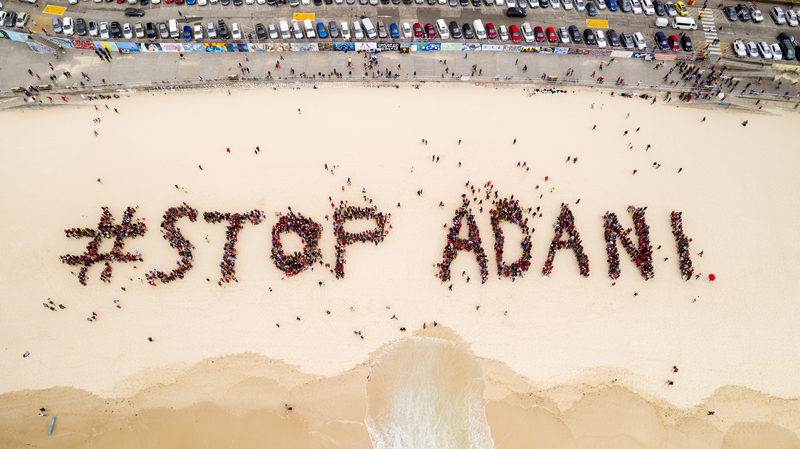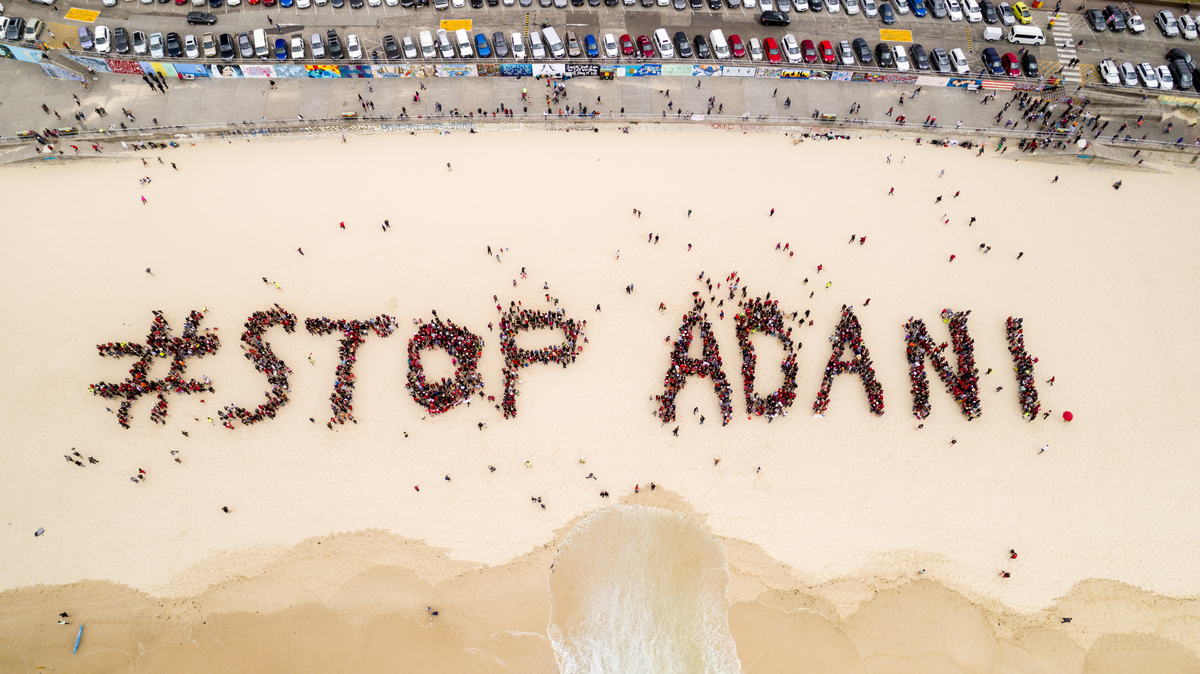This case study was written by Greig Aitken of BankTrack for our latest bank report card, Banking on Climate Change: Fossil Fuel Finance Report Card 2018 .
 PHOTO: Max Phillips / Stop Adani
PHOTO: Max Phillips / Stop Adani
A high farce has played out in Australia over the last year involving the Indian conglomerate Adani’s efforts to find financing for its proposed Carmichael coal mine, as many banks have explicitly refused to cover the project’s estimated $12.8 billion price tag.1 This points to a wider and fast-encroaching reality for coal mining companies: more and more commercial banks — even the Chinese banks at the top of the sector league table — are saying no to coal mine projects.
The Carmichael “mega” mine could potentially produce a climate-busting 60 million tons of coal annually, mostly for export to India.2 To do so would require moving the coal by rail from the Galilee Basin in north-east Australia to Adani’s Abbot Point export terminal, with severe impacts expected for the neighboring Great Barrier Reef World Heritage Area if such a major ramping up of coal export traffic were to ever materialize.3 The Carmichael mine would also cause devastating impacts on the traditional Indigenous lands on which Adani has proposed the mine. The Wangan and Jagalingou people,4 the traditional owners of the land in the Galilee Basin, have been spearheading resistance to the project and Adani has failed to secure an Indigenous land use agreement.5
In tandem with Indigenous resistance, long-running NGO campaigning has resulted in a total of 28 banks ruling out funding for Galilee Basin coal export projects.6 This includes Australia’s four main banks, whose overall coal financing has decreased by 75 percent over the last three years.7 Most strikingly, a crescendo of knock-backs for Adani arrived over a few days in December 2017 from China Construction Bank, ICBC, Bank of China, and China Merchants Bank.8 As the Chinese banks are also the biggest bankers of coal mining, these banks are to be congratulated for their stance on Carmichael, in particular as they faced Australian government entreaties and assurances on behalf of Adani.9 The Chinese government’s ambitions to provide global climate leadership have to be matched, however, by its banks moving fast to reject more than just one beleaguered, economically unviable coal mine project in Australia.
February 2018 saw yet another setback for Adani’s plans when rail operator Aurizon unexpectedly pulled out of building the rail link, citing its inability to secure contracts with customers.10
The toxicity of the Carmichael project is further highlighted by Adani’s apparent failure to entice the US debt market, after which the company missed its latest deadline to secure financing for the mine by March 2018.11 While the latest polling suggests that public opposition to Adani is surging in Australia,12 campaigner vigilance remains high,13 as the Carmichael project still makes up half of Adani’s book value.14
This is Big Coal’s tragedy playing out in full public view. Adani’s desperate efforts to attract billions in funding for the massive new infrastructure required to open up a new coal basin isn’t going well with a finance industry increasingly attuned, as the global climate imperative gathers steam, to the threat of stranded assets. Meanwhile, salt is being rubbed into Adani’s wounds with its Mundra coal plant in India in dire straits — a supposed key off-taker of Carmichael coal. The company’s latest financial results show its profits from coal mining are decreasing.15
Adani has dragged its reputation through the mud in Australia, and potential financiers have expressed one of the most universal and unambiguous expressions of aversion to a project. Banks should now be showing the same level of zero tolerance to Adani’s coal power expansion plans, given the company’s high ranking on the Coal Plant Developers list, a list of the companies with the most destructive coal power buildout plans.16
To support various campaigns working to Stop Adani, visit http://wanganjagalingou.com.au/our-fight/ or https://www.stopadani.com/.
1. “Who’s Out of Galilee Coal Export Projects?” Market Forces, accessed March 2018. 
2. John Power,“Australia’s Biggest Mine Faces Fresh Hurdles,” Nikkei Asian Review, 28 December 2017. 
3. https://www.marineconservation.org.au/pages/adani-carmichael-coal-mine-rail-project-factsheet-.html Australian Marine Conservation Society, accessed March 2018
4. “Stop Adani Destroying our Land and Culture,” Wangan and Jagalingou Family Council, accessed March 2018.
5. Joshua Robertson, “Indigenous Opponents of Adani’s Carmichael Mine to Intensify Court Battle,” EThe Guardian, 16 March 2016. 
6. “Adani’s Carmichael Coal Mine and Rail Project: Factsheet,” Australian Marine Conservation Society, accessed March 2018. 
7. Analysis of the dataset researched for this report.
8. “Chinese Banks Rule out Carmichael Coal Mine!” Market Forces, 13 December 2017. 
9. See the coal mining league table in the report card; Alexandra Blucher and Louisa Rebgetz, “Adani: Government Gives Assurance to China Over Coal Mine Project Approvals, George Brandis Says,” ABC News, 26 October 2017. 
10. Perry Williams, “Adani’s Giant Australian Coal Mine Takes Hit as Rail Plan Axed,” Bloomberg, 9 February 2018. 
11. Michael Slezak,“Adani Abandons March Deadline to Secure Funding for Carmichael Coalmine,” The Guardian, 21 February 2018.
12. James Massola,“Big Surge in Opposition to Adani, New Polling Reveals,” The Sydney Morning Herald, 2 February 2018. 
13. Julien Vincent, “Adani’s Mega Mine: It’s Not Over Yet,” The Sydney Morning Herald, 10 January 2018. 
14. Tim Buckley and Simon Nicholas, “The Further Unravelling of Adani’s Carmichael Coal Project,” RenewEconomy, 19 December 2017.
15. Tim Buckley and Simon Nicholas,“Adani Stumbles Towards the Last-chance Saloon,” Institute for Energy Economics and Financial Analysis, 19 January 2018. 
16. “Coal Plant Developers Database,” urgewald, November 2017.












